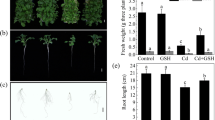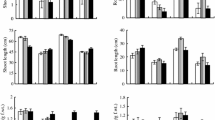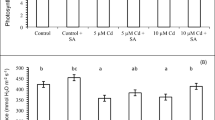Abstract
This study was conducted to examine how glycine betaine (GB) ameliorates the toxic effects of cadmium (Cd) in super black waxy maize. In a Cd toxicity test, biomass accumulation in maize seedlings decreased in comparison with those in the control group (CK). The maize plants exposed to Cd stress exhibited reductions in photosynthetic parameters [net photosynthetic rate (Pn), stomatal conductance (Gs), intracellular CO2 concentration (Ci) and transpiration rate (E)], chlorophyll content and maximum photosynthetic efficiency (Fv/Fm). However, the exogenous application of GB alleviated the negative effects of Cd stress and increased the biomass, photosynthetic parameters (Pn, Gs, Ci, E), chlorophyll content and Fv/Fm of the seedlings. In addition, Cd can decrease the activity of antioxidant enzymes and ascorbic acid (AsA)-glutathione (GSH) cycle enzymes, such as superoxide dismutase, peroxidase, catalase, ascorbate peroxidase, dehydroascorbate reductase, monodehydroascorbate reductase and glutathione reductase, but the activity of these enzymes increased following GB addition. Cd also increased markedly the content of reactive oxygen species and malondialdehyde, but supplementation with GB significantly decreased their content. Furthermore, the levels of AsA and GSH decreased under treatment with Cd, but exogenous GB application increased the content of these compounds. This study shows that GB can alleviate Cd toxicity and provides a theoretical basis for super black maize resistance to heavy metal stress.






Similar content being viewed by others
References
Alemayehu A, Zelinová V, Bočová B, Huttová J, Mistrík I, Tamás L (2015) Enhanced nitric oxide generation in root transition zone during the early stage of cadmium stress is required for maintaining root growth in barley. Plant Soil 390:213–222
Ali B, Qian P, Jin R, Ali S, Khan M, Aziz R, Tian T, Zhou W (2014) Physiological and ultra-structural changes in Brassica napus seedlings induced by cadmium stress. Biol Plant 58:131–138
Anjum NA, Pereira ME, Ahmad I, Duarte AC, Umar S, Khan NA (2013) Phytotechnologies: remediation of environmental contaminants international. Int J Environ An Ch 93:1557–1558
Ashraf M, Nawaz K, Athar HR, Raza SH (2008) Growth enhancement in two potential cereal crops, maize and wheat, by exogenous applicationation of glycinebetaine. In: Abdelly C, Öztürk M, Ashraf M, Grignon C (eds) Biosaline Agriculture and High Salinity Tolerance. Birkhäuser, Switzerland, pp 21–35
Baker NR, Harbinson J, Kramer DM (2007) Determining the limitations and regulation of photosynthetic energy transduction in leaves. Plant Cell Environ 30:1107
Banu MNA, Hoque MA, Watanabe-Sugimoto M, Matsuoka K, Nakamura Y, Shimoishi Y, Murata Y (2009) Proline and glycinebetaine induce antioxidant defense gene expression and suppress cell death in cultured tobacco cells under salt stress. J Plant Physiol 166:146–156
Bradford MM (1976) A rapid and sensitive method for the quantitation of microgram quantities of proteins utilizing the principle of enzyme-dye binding. Anal Biochem 72:248–254
Chen TH, Murata N (2015) Glycinebetaine protects plants against abiotic stress: mechanisms and biotechnological applications. Plant Cell Environ 34:1–20
Cherif J, Derbel N, Nakkach M, Mediouni C, Bergmann HV, Jemal F, Lakhdar ZB (2011) Detection of photosynthetic activity under cadmium stress by measurement of the red and far-red chlorophyll fluorescence. Int J Remote Sens 32:4233–4248
Crowe JH, Hoekstra FA, Crowe LM (1992) Anhydrobiosis. Annu Rev Physiol 54:579–599
Gill SS, Tuteja N (2011) Cadmium stress tolerance in crop plants: probing the role of sulfur. Plant Signal Behav 6:215–222
Gill SS, Khan NA, Tuteja N (2012) Cadmium at high dose perturbs growth, photosynthesis and nitrogen metabolism while at low dose it up regulates sulfur assimilation and antioxidant machinery in garden cress (Lepidium sativum L.). Plant Sci 182:112–120
Gill SS, Hasanuzzaman M, Nahar K, Macovei A, Tuteja N (2013) Importance of nitric oxide in cadmium stress tolerance in crop plants. Plant Physiol Bioch 63:254–261
Guo B, Liang YC, Zhu YG (2009) Does salicylic acid regulate antioxidant defense system, cell death, cadmium uptake and partitioning to acquire cadmium tolerance in rice? J Plant Physiol 166:20–31
Hissin PJ, Hilf R (1976) A fluorometric method for determination of oxidized and reduced glutathione in tissues. Anal Biochem 74:214–226
Hoque MA, Banu MN, Okuma E, Amako K, Nakamura Y, Shimoishi Y, Murata Y (2007) Exogenous proline and glycinebetaine increase NaCl-induced ascorbate-glutathione cycle enzyme activities, and proline improves salt tolerance more than glycinebetaine in tobacco Bright Yellow-2 suspension-cultured cells. Plant Physiol 164:1457–1468
Hoque MA, Banu MN, Nakamura Y, Shimoishi Y, Murata Y (2008) Proline and glycinebetaine enhance antioxidant defense and methylglyoxal detoxification systems and reduce NaCl-induced damage in cultured tobacco cells. J Plant Physiol 165:813–824
Hossain MA, Fujita M (2010) Evidence for a role of exogenous glycinebetaine and proline in antioxidant defense and methylglyoxal detoxification systems in mung bean seedlings under salt stress. Physiol Mol Biol Pla 16:19–29
Islam MM, Hoque MA, Okuma E, Banu MN, Shimoishi Y, Nakamura Y, Murata Y (2009a) Exogenous proline and glycinebetaine increase antioxidant enzyme activities and confer tolerance to cadmium stress in cultured tobacco cells. J Plant Physiol 166:1587
Islam MM, Hoque MA, Okuma E, Jannat R, Banu MNA, Jahan MS, Nakamura Y, Murata Y (2009b) Proline and glycinebetaine confer cadmium tolerance on tobacco bright yellow-2 cells by increasing ascorbate-glutathione cycle enzyme activities. Biosci Biotech Bioch 73:2320–2323
Kalai T, Khamassi K, Silva JATD, Gouia H, Ben-Kaab LB (2014) Cadmium and copper stress affect seedling growth and enzymatic activities in germinating barley seeds. Arch Agron Soil Sci 60:765–783
Kampfenkel K, Vanmontagu M, Inze D (1995) Extraction and determination of ascorbate and dehydroascorbate from plant tissue. Anal Biochem 225:165–167
Karpinski S, Escobar C, Karpinska B, Creissen G, Mullineaux PM (1997) Photosynthetic electron transport regulates the expression of cytosolic ascorbate peroxidase genes in Arabidopsis during excess light stress. Plant Cell 9:627
Khalid A, Athar H, Zafar ZU, Akram A, Hussain K, Manzoor H, Al-Qurainy F, Ashraf M (2015) Photosynthetic capacity of canola (Brassica napus L.) plants as affected by glycinebetaine under salt stress. J Appl Bot Food Qual 88:78–86
Kurepin LV, Ivanov AG, Zaman M, Pharis RP, Allakhverdiev SI, Hurry V, Hüner NPA (2015) Stress-related hormones and glycinebetaine interplay in protection of photosynthesis under abiotic stress conditions. Photosynth Res 126:221–235
Li Q, Yu B, Gao Y, Dai AH, Bai JG (2011) Cinnamic acid pretreatment mitigates chilling stress of cucumber leaves through altering antioxidant enzyme activity. J Plant Physiol 168:927
Li DM, Nie YX, Zhang J, Yin JS, Li Q, Wang XJ, Bai JG (2013) Ferulic acid pretreatment enhances dehydration-stress tolerance of cucumber seedlings. Biol Plant Arum 57:711–717
Liu DH, Wang M, Zou JH, Jiang WS (2006) Uptake and accumulation of cadmium and some nutrient ions by roots and shoots of maize (Zea mays L.). Pak J Bot 38:701–709
Ma F, Cheng L (2003) The sun-exposed peel of apple fruit has higher xanthophyll cycle-dependent thermal dissipation and antioxidants of the ascorbate–glutathione pathway than the shaded peel. Plant Sci 165:819–827
Mahmood T, Gupta KJ, Kaiser WM (2009) Cadmium stress stimulates nitric oxide production by wheat roots. Pak J Bot 41:1285–1290
Mäkelä P, Kärkkäinen J, Somersalo S (2000) Effect of glycinebetaine on chloroplast ultrastructure, chlorophyll and protein content, and RuBPCO activities in tomato grown under drought or salinity. Biol Plant 43:471–475
Malčovská SM, Dučaiová Z, Maslaňáková I, Bačkor M (2014) Effect of silicon on growth, photosynthesis, oxidative status and phenolic compounds of maize (Zea mays L.) grown in cadmium excess. Water Air Soil Poll 225:1–11
Nedjimi B (2018) Heavy metal tolerance in two algerian saltbushes: a review on plant responses to cadmium and role of calcium in its mitigation. In: Hasanuzzaman M, Fujita M, Oku H, Nahar K, Hawrylak-Nowak B (eds) Plant Nutrients and Abiotic Stress Tolerance. Springer, Singapore, pp 205–220
Nusrat N, Shahbaz M, Perveen S (2014) Modulation in growth, photosynthetic efficiency, activity of antioxidants and mineral ions by foliar application of glycinebetaine on pea (Pisum sativum L.) under salt stress. Acta Physiol Plant 36:2985–2998
Pál M, Horváth E, Janda T, Páldi E, Szalai G (2006) Physiological changes and defense mechanisms induced by cadmium stress in maize. J Plant Nutr Soil Sc 169:239–246
Peng H et al (2015) Transcriptomic changes during maize roots development responsive to Cadmium (Cd) pollution using comparative RNA seq-based approach. Biochem Bioph Res Co 464:1040
Rady MM (2011) Effect of 24-epibrassinolide on growth, yield, antioxidant system and cadmium content of bean (Phaseolus vulgaris L.) plants under salinity and cadmium stress. Sci Hortic-Amsterdam 129:232–237
Rahman A, Mostofa MG, Nahar K, Hasanuzzaman M, Fujita M (2016) Exogenous calcium alleviates cadmium-induced oxidative stress in rice (Oryza sativa L.) seedlings by regulating the antioxidant defense and glyoxalase systems. Braz J Bot 39:393–407
Raza SH, Athar HR, Ashraf M, Hameed A (2007) Glycinebetaine-induced modulation of antioxidant enzymes activities and ion accumulation in two wheat cultivars differing in salt tolerance. Environ Exp Bot 60:368–376
Semane B, Cuypers A, Smeets K, Van Belleghem F, Horemans N, Schat H, Vangronsveld J (2010) Cadmium responses in Arabidopsis thaliana: glutathione metabolism and antioxidative defence system. Physiol Plant 129:519–528
Shan CJ, Liang ZS (2010) Jasmonic acid regulates ascorbate and glutathione metabolism in Agropyron cristatum leaves under water stress. Plant Sci 178:130–139
Shi G, Liu C, Cui M, Ma Y, Cai Q (2012) Cadmium tolerance and bioaccumulation of 18 hemp accessions. Appl Biochem Biotech 168:163–173
Tian SK, Lu LL, Yang XE, Huang HG, Wang K, Brown PH (2012) Root adaptations to cadmium-induced oxidative stress contribute to Cd tolerance in the hyperaccumulator Sedum alfredii. Biol Plant 56:344–350
Toppi LSD, Gabbrielli R (1999) Response to cadmium in higher plants. Environ Exp Bot 41:105–130
Wan YY, Zhang Y, Zhang L, Zhou ZQ, Li X, Shi QH, Wang XJ (2015) Caffeic acid protects cucumber against chilling stress by regulating antioxidant enzyme activity and proline and soluble sugar contents. Acta Physiol Plant 37:1–10
Wu F, Zhang G, Dominy P, Wu H, Bachir DM (2007) Differences in yield components and kernel Cd accumulation in response to Cd toxicity in four barley genotypes. Chemosphere 70:83–92
Zhang LX, Lai JH, Gao M, Ashraf M (2014) Exogenous glycinebetaine and humic acid improve growth, nitrogen status, photosynthesis, and antioxidant defense system and confer tolerance to nitrogen stress in maize seedlings. J Plant Interact 9:159–166
Acknowledgements
We acknowledge the Natural Science Fund of Education Department of Anhui Province (KJ2012A254) and the Huaibei Talent Fund Project (20130301) for supporting this study.
Author information
Authors and Affiliations
Corresponding author
Additional information
Communicated by Á. Gallé.
Rights and permissions
About this article
Cite this article
Zhang, G., Ba, Q., Chen, S. et al. Exogenous application of glycine betaine alleviates cadmium toxicity in super black waxy maize by improving photosynthesis, the antioxidant system and glutathione-ascorbic acid cycle metabolites. CEREAL RESEARCH COMMUNICATIONS 48, 449–458 (2020). https://doi.org/10.1007/s42976-020-00062-9
Received:
Accepted:
Published:
Issue Date:
DOI: https://doi.org/10.1007/s42976-020-00062-9




